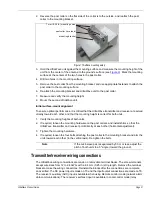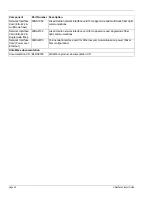
Setup
UltraWave Product Guide
Page 35
7. Save and download the configuration changes to the receiver unit.
Setting the receiver’s address
The receiver address can be set only by using a direct USB connection between the UCM
computer and the USB port on the receiver. Only network-based UltraWave sensors require
unique address settings. Systems that do not use network communications can use the default
address of 1. The transmitter unit does not require an address setting.
1. In the Program field select the Address button.
The change Device Address dialog displays.
2. In the Change Device Address dialog, specify the New Address for the connected receiver.
3. Select the Program button.
The New Address takes effect when communications are re-established.
4. Save the configuration changes.
Network configuration
For UltraWave receivers that use network alarm data communications, you must define the
network type under the Network Cfig tab. The network configuration can be set only by using a
direct USB connection between the UCM computer and T3, the USB port on the processor.
1. Specify the type of alarm data network (Silver Loop, Silver Star, or Crossfire).
2. For the Crossfire network you must specify the baud rate (all devices on a Crossfire network
must communicate at the same baud rate).
For the Silver Star you specify the IP Address, the Subnet Mask and the Gateway IP Address
(if required).
3. Save and download the configuration changes to the processor.
Specify the Auxiliary I/O control mode
Specify the control mode for the UltraWave units (Local control or Remote control).
1. Select the Aux Cfig tab.
2. Use the Aux Control arrow to specify the control mode (Local or Remote).
3. Save and download the configuration changes to the UltraWave unit.
Auxiliary/self-test input
In Remote Control mode, the receiver’s AUX input is used to report the status of an auxiliary
device to the security management system. In Local control mode, the input is used to activate an
electronic self-test of the receiver unit. The receiver determines the input’s status via an internal
reference voltage, and the configuration of the contact closures and supervision resistors. Input
contact closures must be voltage-free.
Note
You raise an alarm Threshold to decrease the sensitivity to the
specified type of intrusion, or you lower a Threshold to increase the
sensitivity.
To determine the settings that are appropriate for your site, adjust the
Thresholds, and then perform detection tests. Custom Threshold
settings can provide a good probability of detection and a very low
nuisance alarm rate.






























